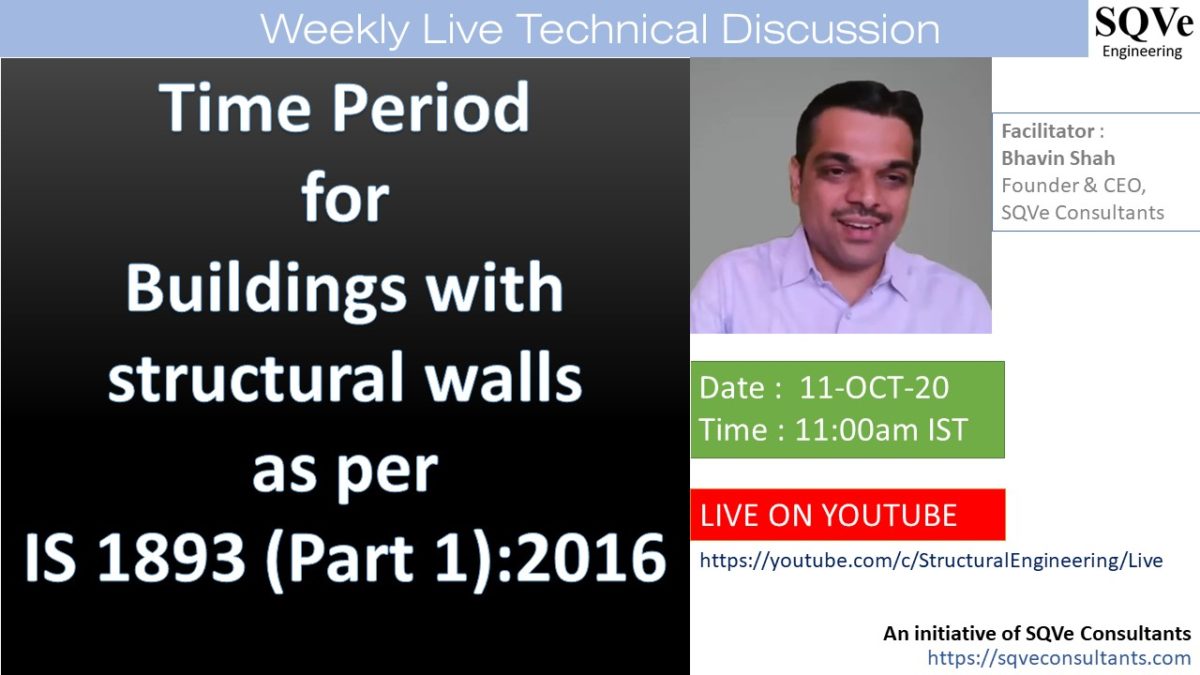I have received many queries related to time period calculations for buildings with shear wall in accordance with cl no. 7.6.2 of IS 1893 (Part 1) : 2016. Time period is very sensitive parameter with respect to earthquake resistant design. In the article, I have shared my understanding related to the clause for further comments/suggestions.
Background:
In the IS 1893 (Part 1):2016, empirical formula for calculation of time period is defined in cl no. 7.6.2. In the clause, formulae are defined for three different types of structural systems:
(only part details are shown in the below content. Please refer the code for complete details).
a) Bare MRF buildings (without any masonry infills)
· RC MRF buildings
· RC-Steel composite MRF building
· For steel MRF building
b) Buildings with RC structural walls
c) All other buildings
For buildings with RC structural walls, the following formula was included in the code when it was published:

Wherein Aw can be calculated using the following formula,

Thereafter, the amendment no. 1 was released in 2017 and in the amendment, the above mentioned formula for Aw was updated as under:

Opinion of the engineers :
I believe that the majority of engineers are of the opinion that the earlier formula which was mentioned in IS 1893 (Part 1):2016 was correct and there is error in the revised formula (amendment no. 1).
My observations on the formula for time period:
1) In case of open storey, as per cl no. 7.10.4 of the code, when the RC structural walls are provided, the RC structural wall plan density of the building shall be at least 2 percent along each principal direction in seismic zones III, IV and V. RC structural walls of this measure can be adopted even in regular buildings that do not have open storey(s).
2) As per cl. no. 7.6.2, the time period for buildings with structural walls need not be less than 0.09*h/SQRT (d). Based on few worked out examples, I observed that the time period derived from earlier Aw formula of the code along with 2% of shear wall in each principal direction was generally near to 0.09*h/SQRT (d).
However, with the amendment formula of Aw, the time period considering 2% of shear wall, was significantly higher than the time period which is derived from 0.09*h/SQRT (d).
With this anomaly, I believe that the majority of engineers are of the opinion that the earlier formula of Aw was appropriate.
3) In my opinion, the structures with RC structural walls (shear walls) will be the most rigid one as compared to the Bare MRF buildings and the other buildings, as defined in cl no. 7.6.2. I think the upper limit of time period for buildings with RC structural walls may be defined as 0.09*h/SQRT (d). The upper cap limit may be defined or altered for range of height of the building.
4) I think that the more examples may be worked out for checking appropriateness of the above mentioned formulas.
Live Technical Discussion on next Sunday ( 11-Oct-20 at 11:00am):
SQVe Consultants have taken up the initiative for launching the “weekly live technical discussion” series for focusing on the areas wherein industry is facing practical difficulties. To know more about SQVe : https://sqveconsultants.com The topic will be decided in advance and the technical discussion will be conducted through the live stream at youtube. The sessions will be organized on every Sunday at 11:00am. Facilitator : Bhavin Shah (Founder & CEO, SQVe Consultants)
During next live technical discussion, we will take up this interesting area for discussion. Please join us in the live session.
I have shared my views on the subject. Your valuable comments/suggestions are welcome for further improvement in this article. The suggested points may be taken up during the live technical discussion of 11-Oct-20 at 11:00am.
Bhavin Shah
Founder & CEO, SQVe Consultants
